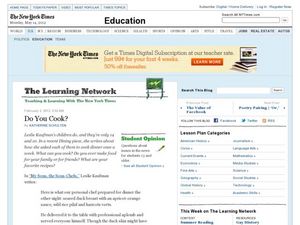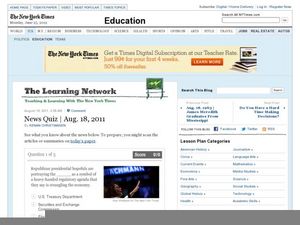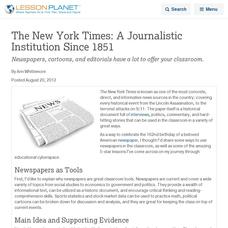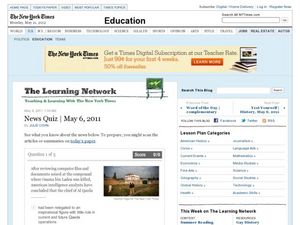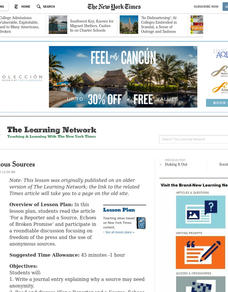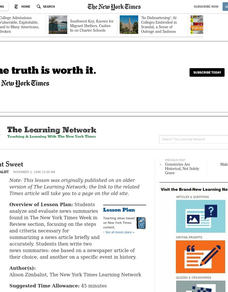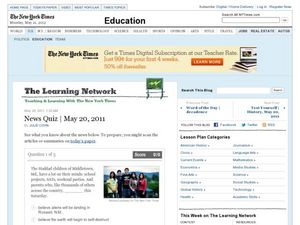Curated OER
Children Cooking at Home: Developing Opinions
Excerpts from a New York Times article about children cooking dinner for their family can lead learners to express opinions about taking on real life responsibilities. The story will prompt discussion, but add more questions directed at...
Curated OER
Today's News, Tomorrow's History
Students read and analyze the historic New York Times front pages, and read an article that focuses on the current housing slump and the effect on state budgets. They answer comprehension questions, then in small groups answer questions...
Curated OER
News Quiz: Dec. 2, 2011
Quiz the class on how much they know about the daily news. They read or scan several New York Times articles published on December 2, 2011, then answer each of the five related multiple choice questions.
Curated OER
News Quiz | Aug. 18, 2011
Take the time to review the daily news with your class. They can peruse the August 18, 2011 edition of the New York Times, before answering a five-question quiz. Current events, check!
Curated OER
News Quiz | May 23, 2011
Reading the daily newspaper is a wonderful way to stay informed on current events and world happenings. After scanning the May 23, 2011 edition of the New York Times, kids can take a fun quiz. A great way to stay on top of hot topics.
Curated OER
The Violence in Syria
Several New York Times articles were used to create informative reading material. Kids click on each of the embedded links to access a resource related to Syria and the Middle East conflict. They then answer the nine questions. Note:...
Curated OER
The New York Times: A Journalistic Institution Since 1851
Newspapers, cartoons, and editorials have a lot to offer your classroom.
Curated OER
The Politics of Student Loans
Give your upper classmen something to think about. They'll read a New York Times article on the politics of student loans. The six comprehension questions will have them thinking about the impact legislation has on how much they'll pay...
Curated OER
Fill in - Twinkies
After hearing or reading a New York Times article on Twinkies, kids attempt to fill in the blanks by memory alone. They re-read the article, only this time words are missing, it's up to them to fill in each blank with a word from the...
Curated OER
News or Propaganda?
What is considered news vs. propaganda? Learners will discuss objectivity and press responsibility while exploring these two concepts. They work in small groups to explore the article in-depth, guided by reading comprehension and...
Curated OER
News Quiz | Sept. 30, 2011
World affairs and current events are the name of the game. Today your class can read the Times, published on September 30, 2011 and then take a five question quiz to test their recall abilities.
Curated OER
News Quiz | May 6, 2011
News Quizzes can be a fun way for learners to test their own knowledge. They read the Times published on May 6, 2011 and then take a five question online quiz. This quiz can also be printed.
Curated OER
News Quiz | Oct. 14, 2011
When someone asks your class what events were featured in the Times on October 14, 2011, they'll have an answer. They read the paper from that day, then take a five question multiple choice quiz.
Rockefeller Archive Center
Understanding Mass Media News
In an age of fake news and photoshopped images, it is vital that 21st century learners development the skills they need to evaluate mass media and assess its validity. A great way to launch such a study is with a carefully crafted lesson...
Curated OER
Anonymous Sources in the Media
When do people ask for anonymity? Why? After reading the New York Times article "For a Reporter and a Source, Echoes of Broken Promise," young readers participate in a roundtable discussion focusing on freedom of the press and the use of...
Curated OER
A Way with Words
How do facts and opinions impact the news? After reading "How to Cover a War" from the New York Times, middle schoolers evaluate the claims in the article. They also consider the media's responsibilities in reporting during wartime....
Curated OER
Short But Sweet
After analyzing and evaluating news summaries found in the New York Times "Week in Review" section, middle schoolers study the steps for summarizing a news article briefly and accurately. They write two news summaries: one on a newspaper...
Curated OER
Let's Be Honest!
Students investigate the concepts of honesty and take a survey about honesty. They use the New York Times to conduct research to identify the characteristics commonly found in stories about cheating. Students write reflective papers...
Curated OER
News Quiz | April 4, 2012
Everyday there are new headlines to excite your class. After a quick look at the April 4, 2012 edition of the New York Times, your class will take a topical quiz. Find out what they know about current events, and what they retained from...
Curated OER
News Quiz | April 25, 2012
Hospital collection agencies are the topic of the April 25, 2012 edition of the New York Times. Kids will tackle this and other issues as they read the daily news and take a five-question quiz.
Curated OER
The Internet of Things: IoT
How has the Internet of Things affected our lives? Scholars examine the massive influence of mobile devices in this analysis lesson, which begins with a seven-minute documentary clip. They also read a New York Times article (linked)...
Curated OER
News Quiz | Feb. 8, 2012
Take time to check the our the daily news. Learners read a copy of the Times published on February 8, 2012 and then take a five question quiz. A great way to introduce the daily paper to your class.
Curated OER
News Quiz | May 20, 2011
Take this daily news quiz to see how informed you are about events that made headlines on May 20, 2011. Check out each of the five questions in the quiz, read or scan the paper to find the answers, and then take the quiz to test your...
Curated OER
The State of "No Child Left Behind"
Your class can read about the changes Obama considered making to Bush's No Child Left Behind Act. After reading the article, pupils answer 13 questions that ask, who, what, when, where, and why.


